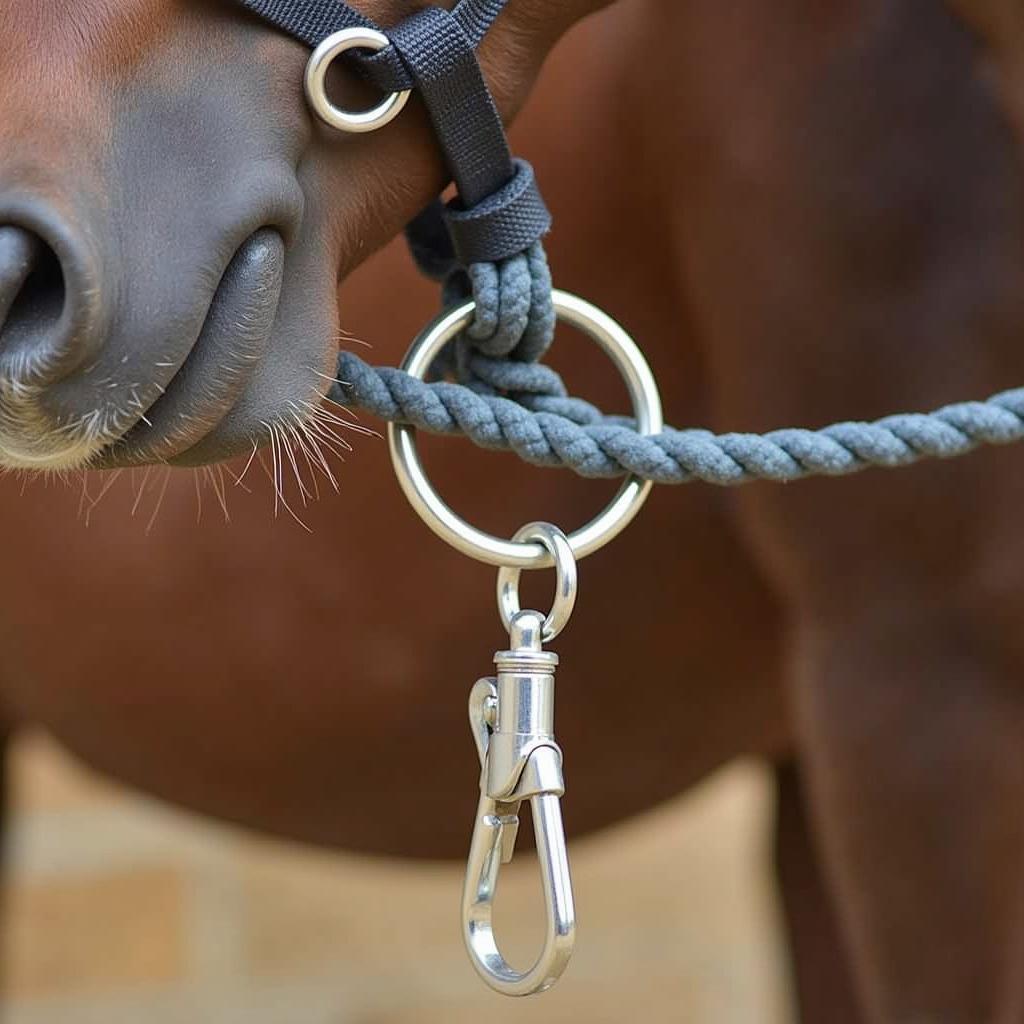Rings For Horses play a vital role in equine management and training. From the basic halter ring to specialized rings for various equipment, understanding their function and choosing the right ones is crucial for every horse owner. This guide explores the different types of rings for horses, their uses, and how to select the best options for your equine companion.
Types of Rings and Their Uses
Horses interact with a variety of rings throughout their lives. Some are essential for everyday handling, while others are specific to certain disciplines or equipment.
Halter Rings
The most common ring a horse encounters is the halter ring. This is the central ring on a halter where the lead rope attaches. A sturdy and reliable halter ring is essential for safe handling and control. Choosing a halter with a strong, well-made ring is paramount.
Rings for Bits and Bridles
Bits and bridles utilize several rings for different purposes. Snaffle bits often feature rings on either side of the mouthpiece, while curb bits have shanks with rings for attaching reins and curb chains. These rings influence the bit’s action and how pressure is applied to the horse’s mouth. Understanding the placement and function of these rings is key to effective communication and training. You might want to explore our collection of eye coverings for horses for additional information on equine accessories.
Rings for Tying and Tethering
Rings are crucial for safely tying and tethering horses. These can be found on halters, lead ropes, and in stables or trailers. Strong, securely fastened rings are necessary to prevent accidents and injuries. Quick-release snaps, while convenient, must be checked regularly for wear and tear. Explore our hay bale ring for horses for safe and efficient feeding solutions.
Specialized Rings for Training and Equipment
Various specialized rings cater to specific disciplines or equipment. Longeing reins often have rings for attaching side reins, and driving harnesses utilize multiple rings for connecting reins and other components. Understanding the purpose of these specialized rings is crucial for safe and effective use. Looking for more stable essentials? Check out our hay racks for horses.
Choosing the Right Rings for Your Horse
Selecting appropriate rings depends on their intended use. Durability, material, and size are important considerations. Solid brass or stainless steel rings are often preferred for their strength and resistance to corrosion. For aesthetic purposes, some owners might choose decorative rings. However, functionality and safety should always be prioritized. Perhaps you might also be interested in our canvas painting of horses for your home.
 A horse tied safely with a quick-release snap on a strong ring
A horse tied safely with a quick-release snap on a strong ring
Maintaining and Inspecting Rings
Regular inspection and maintenance are vital for ensuring the safety and longevity of rings. Check for signs of wear, cracks, or loose connections. Replace worn or damaged rings immediately to prevent accidents.
Conclusion
Rings for horses are essential tools for handling, training, and managing these magnificent animals. Understanding the different types, their functions, and how to choose and maintain them is paramount for responsible horse ownership. By selecting the right rings and ensuring their proper upkeep, you can contribute to the safety and well-being of your equine partner. Remember to prioritize quality, durability, and suitability for the intended purpose when choosing rings for horses.
FAQs about Rings for Horses
- What material is best for horse rings? Stainless steel and brass are commonly recommended for their strength and durability.
- How often should I check my horse’s rings? Regularly inspect rings, especially those used for tying and attaching equipment, for signs of wear.
- Can I use decorative rings for everyday handling? While decorative rings can be aesthetically pleasing, prioritize functionality and safety when choosing rings for handling.
- What should I do if a ring breaks? Replace broken rings immediately to prevent accidents and ensure the safety of your horse.
- Are quick-release snaps safe for tying horses? Quick-release snaps can be convenient but should be checked regularly for wear and tear and used with caution.
- Where can I buy quality rings for my horse? Reputable tack shops and online retailers specializing in equine equipment are good sources for quality rings.
- What size ring do I need for my horse’s halter? Halter ring size depends on the size of the halter and the horse. Consult a professional for guidance if needed.
Common Scenarios Involving Rings for Horses
- Scenario 1: A horse pulls back while tied with a weak ring. The ring breaks, causing the horse to panic and potentially injure itself.
- Scenario 2: A rusty ring on a bridle snaps during a ride, leading to loss of control and a potential accident.
- Scenario 3: A worn-out quick-release snap on a lead rope fails, allowing the horse to get loose in a busy area.
Further Reading and Resources
You might also find helpful information on our website regarding earrings horse.
Contact Us
For any assistance or inquiries, please contact us: Phone: 0772127271, Email: [email protected] or visit us at QGM2+WX2, Vị Trung, Vị Thuỷ, Hậu Giang, Việt Nam. Our customer service team is available 24/7.